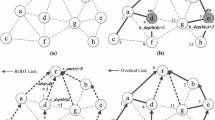Abstract
Recently Wireless Mesh Networks (WMNs) have emerged as a key technology for providing high-bandwidth networking among peer nodes over a specific coverage area. Features such as low cost, ease of deployment, self-configuration and self-healing make them one of the most promising global telecommunication systems. Despite their advantages, however, several research challenges remain in all protocol layers. In this paper, we address the main challenging issues related to the routing aspects in a WMN. Routing in such networks is performed through multi-hop paths where intermediate nodes cooperatively make forwarding decisions based on their knowledge regarding the network topology. However, in an unideal dynamic environment due to frequent or rare node failures/misbehavior, traditional ad-hoc routing protocols suffer from high routing overhead or energy consumption. Motivated by this, we propose several path selection algorithms which adapt to such topology dynamics. The main objective of these routing schemes is to provide fault tolerance without sacrificing the energy and computational complexity efficiency. Numerical investigations, based on extensive simulations, validate the effectiveness of our proposals even when faulty nodes subsist in the environment.
Similar content being viewed by others
Explore related subjects
Discover the latest articles, news and stories from top researchers in related subjects.References
Bruno, R., Conti, M., & Gregori, E. (2005). Mesh networks: commodity multihop ad hoc networks. IEEE Communications Magazine, 43(3), 123–131.
Akyildiz, I. F., Wang, X., & Wang, W. (2005). A survey on wireless mesh networks. IEEE Radio Communications, 43(9), S23–S30.
Baumann, R., Heimlicher, S., Lenders, V., & May, M. (2007). Routing packets into wireless mesh networks. In IEEE WiMob (pp. 38–38).
Yang, Y., Wang, J., & Kravets, R. (2005). Designing routing metrics for mesh networks. In IEEE workshop on wireless mesh networks, WiMesh.
Kawatra, R. (2007). A hop constrained min-sum arborescence with outage costs. Computers & Operations Research, 34(9), 2648–2656.
Xue, Y., & Nahrstedt, K. (2003). Fault tolerant routing in mobile ad hoc networks. In IEEE WCNC, March (pp. 1174–1179).
Oommen, B. J., & Misra, S. (2006). A fault-tolerant routing algorithm for mobile ad hoc networks using a stochastic learning-based weak estimation procedure. In WiMobapos, June (pp. 31–37).
Nandiraju, N. S., Nandiraju, D. S., & Agrawal, D. P. (2006). Multipath routing in wireless mesh networks. In IEEE MASS, Oct. (pp. 741–746).
Zhang, Z., Greiner, A., & Taktak, S. (2008). A reconfigurable routing algorithm for a fault-tolerant 2D-Mesh network-on-chip. In IEEE design automation conference (pp. 441–746).
Rui, Z.-S., & McKeown, N. (2008). Designing a fault-tolerant network using valiant load-balancing. In IEEE INFOCOM (pp. 2360–2368).
Oh, S.Y., & Gerla, M. (2009). Robust MANET routing using adaptive path redundancy and coding. In IEEE COMSNETS (pp. 1–10).
Krishnamachariy, B., et al. (2003). The energy-robustness tradeoff for routing in wireless sensor networks. In IEEE ICC, May (Vol. 3, pp. 1833–1837).
Zhou, N., Wu, H., & Abouzeid, A. A. (2003). Reactive routing overhead in networks with unreliable nodes. In ACM MCN (pp. 147–160).
Chen, C.-c., Chekuri, C., & Klabjan, D. (2009). Topology formation for wireless mesh network planning. In IEEE INFOCOM, 19–25 April (pp. 2671–).
Vejrazka, F. (2007). Galileo and the other satellite navigation systems. In 17th international conference radioelektronika, 24–25 April (pp. 1–4).
Fredman, M. L., & Tarjan, R. E. (1987). Fibonacci heaps and their uses in improved network optimization algorithms. Journal of Association of Computing Machinery, 34(3), 596–615.
Author information
Authors and Affiliations
Corresponding author
Rights and permissions
About this article
Cite this article
Papapostolou, A., Friderikos, V., Yahiya, T.A. et al. Path selection algorithms for fault tolerance in wireless mesh networks. Telecommun Syst 52, 1831–1844 (2013). https://doi.org/10.1007/s11235-011-9497-1
Published:
Issue Date:
DOI: https://doi.org/10.1007/s11235-011-9497-1




